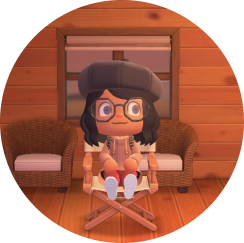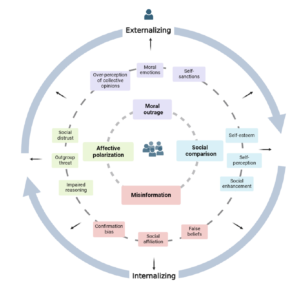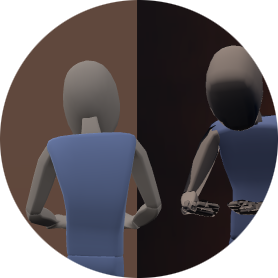Below are short summaries of my research projects and associated publications. If you are interested in reading more about them, please check out my Research Gate or Google Scholar page.
Avatar Creation in Social Experiences
 From Bitmoji to gaming characters, everyone has an avatar these days…but does everyone feel represented in the avatar creation process? What are the hidden norms and values that users engage in when they are creating their avatars? How does this affect how people are ultimately represented and how well they relate to their avatar? In these studies, we investigate how people experience avatar creation and examine how traditionally underrepresented users fit into seemingly pre-determined identity molds through interview and experimental methods.
From Bitmoji to gaming characters, everyone has an avatar these days…but does everyone feel represented in the avatar creation process? What are the hidden norms and values that users engage in when they are creating their avatars? How does this affect how people are ultimately represented and how well they relate to their avatar? In these studies, we investigate how people experience avatar creation and examine how traditionally underrepresented users fit into seemingly pre-determined identity molds through interview and experimental methods.
Pandita, S., Humphreys, L., Won, A.S. (2021). “The Paradox of Customization: Negotiating racial identity with “multiple choice” in avatar creation.” Paper presented at 71st Annual International Association of Communication Conference, May 27-31, Virtual Conference.
Pandita, S. (2022). Affective avatars: Effects of avatar customization on positive and negative emotions. [Doctoral dissertation, Cornell University]. ProQuest Dissertations & Theses Global.
Pandita, S., Humphreys, L., Won, A.S. (2023). “The Paradox of Customization: Negotiating racial identity with “multiple choice” in avatar creation.” PsyArXiv.
Long, T., Pandita, S., & Won, A. S. (2023). Perspectives from Naive Participants and Experienced Social Science Researchers on Addressing Embodiment in a Virtual Cyberball Task. In Computer Supported Cooperative Work and Social Computing (CSCW) (pp. 189-194).
Social Media & Well-being
 We are well aware of the positives and negatives of social media use. However, there is little consensus on how to approach interventions for negative social media use (e.g., social comparison, ostracism, harassment) when it affects our mental health. In this project, we aim to identify the social cognitive aspects of social media based interactions from a multi-disciplinary perspective and create interventions for platforms to implement and support the mental well-being of their users.
We are well aware of the positives and negatives of social media use. However, there is little consensus on how to approach interventions for negative social media use (e.g., social comparison, ostracism, harassment) when it affects our mental health. In this project, we aim to identify the social cognitive aspects of social media based interactions from a multi-disciplinary perspective and create interventions for platforms to implement and support the mental well-being of their users.
Pandita, S., Garg, K., Zhang, J., & Mobbs, D. (2024). Three roots of online toxicity: disembodiment, accountability, and disinhibition. Trends in Cognitive Sciences. https://doi.org/10.1016/j.tics.2024.06.001
Breathing Room
 Virtual reality (VR) provides a promising medium for delivering mood-regulating environments to augment existing therapies. In this study, a series of interviews were conducted with individuals with major depressive disorder (MDD) or persistent depressive disorder (dysthymia) to identify issues with current treatment standards and successful coping strategies. In response to participants’ experiences with depression and its treatment, we created three web-based virtual environments.
Virtual reality (VR) provides a promising medium for delivering mood-regulating environments to augment existing therapies. In this study, a series of interviews were conducted with individuals with major depressive disorder (MDD) or persistent depressive disorder (dysthymia) to identify issues with current treatment standards and successful coping strategies. In response to participants’ experiences with depression and its treatment, we created three web-based virtual environments.
Pandita, S., Difede, J., Won, A.S. (in prep). “Breathing Room: Designing mood regulation spaces for depression.”
Previous Projects
Affective Embodiment
 Can physical manifestations of emotions, such as open and closed body posture, affect how we perceive ourselves? In this study, we explored whether or not affect could be influenced by the perceived display of emotions (body posture) in one’s virtual avatar. More specifically, do humans use or read their body posture to interpret their own emotion states? In other words, just as we read others’ bodily cues and interpret them for sense-making, can the same be done to help us understand our own emotions better?
Can physical manifestations of emotions, such as open and closed body posture, affect how we perceive ourselves? In this study, we explored whether or not affect could be influenced by the perceived display of emotions (body posture) in one’s virtual avatar. More specifically, do humans use or read their body posture to interpret their own emotion states? In other words, just as we read others’ bodily cues and interpret them for sense-making, can the same be done to help us understand our own emotions better?
Pandita, S., Yee, J., & Won, A. S. (2020, March). Affective Embodiment: Embodying emotions through postural representation in VR. In 2020 IEEE Conference on Virtual Reality and 3D User Interfaces Abstracts and Workshops (VRW) (pp. 617-618). IEEE.
Learning Moon Phases in Virtual Reality
 Moon phases are a tricky concept for astronomy students to master due to difficulties in visualizing the changes in phase as a part of the sun-moon-earth system. VR aids in visualization and allows students to control and interact with the moon phases by providing multiple perspectives of the moon phases as it relates to the position of the earth and sun. In this study, we compared the learning outcomes of students who participated in a VR guided moon phases learning activity, a desktop guided activity, and the traditional hands-on (ball and stick model) activity. We found that there were no differences in learning outcomes between the three modalities, however, participants preferred and reported higher satisfaction and presence with the VR intervention.
Moon phases are a tricky concept for astronomy students to master due to difficulties in visualizing the changes in phase as a part of the sun-moon-earth system. VR aids in visualization and allows students to control and interact with the moon phases by providing multiple perspectives of the moon phases as it relates to the position of the earth and sun. In this study, we compared the learning outcomes of students who participated in a VR guided moon phases learning activity, a desktop guided activity, and the traditional hands-on (ball and stick model) activity. We found that there were no differences in learning outcomes between the three modalities, however, participants preferred and reported higher satisfaction and presence with the VR intervention.
Madden, J., Pandita, S., Schuldt, J. P., Kim, B., S. Won, A., & Holmes, N. G. (2020). Ready student one: Exploring the predictors of student learning in virtual reality. PLOS One, 15(3), e0229788.
Sun, Y., Pandita, S., Madden, J. M., Kim, B., Holmes, N. G., Won, A. S. (2023). “Exploring interaction, movement, and video-game experience in an educational VR Experience.” In Extended Abstracts on Human Factors in Computing Systems (CHI).
Social Presence and Perception
Is our pain threshold affected by the perceived social presence of others? Social presence is the “sense of being with another” through physical or digital space. In this study we place individuals in a digital recreation of our lab space and a foreign lab space as they chat with a conversational partner while undergoing a pain task. Another question this study serves to answer is if social presence in virtual reality differs from social presence in the context of instant messaging or other computer-mediated communicative (CMC) modalities.
Won, A. S., Pandita, S., & Kruzan, K. P. (2020). Social Interaction and Pain Threshold in Virtual Reality. Cyberpsychology, Behavior, and Social Networking, 23(12), 829-845.